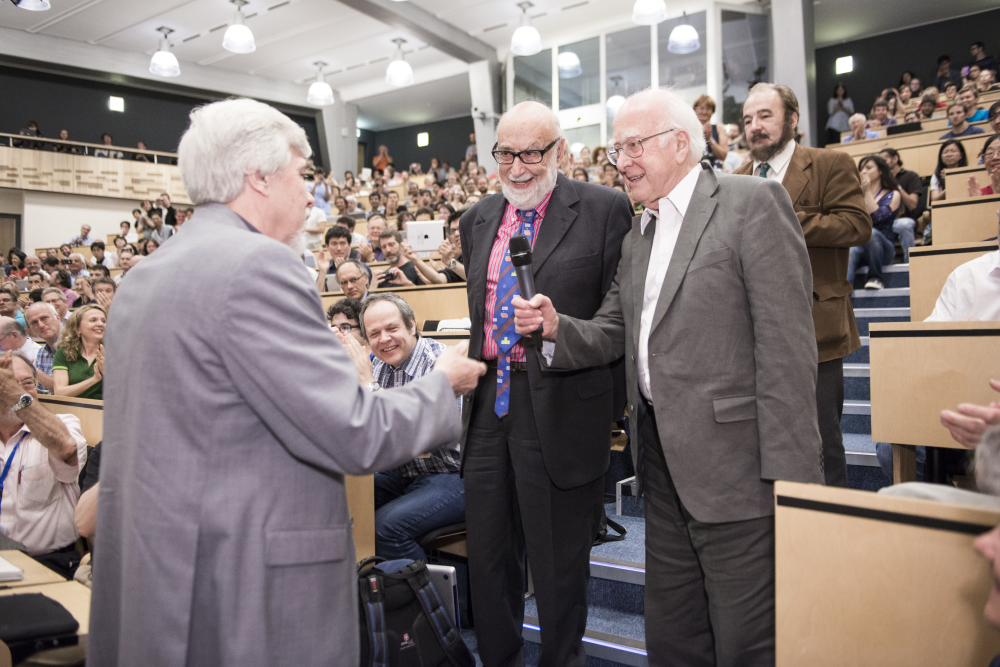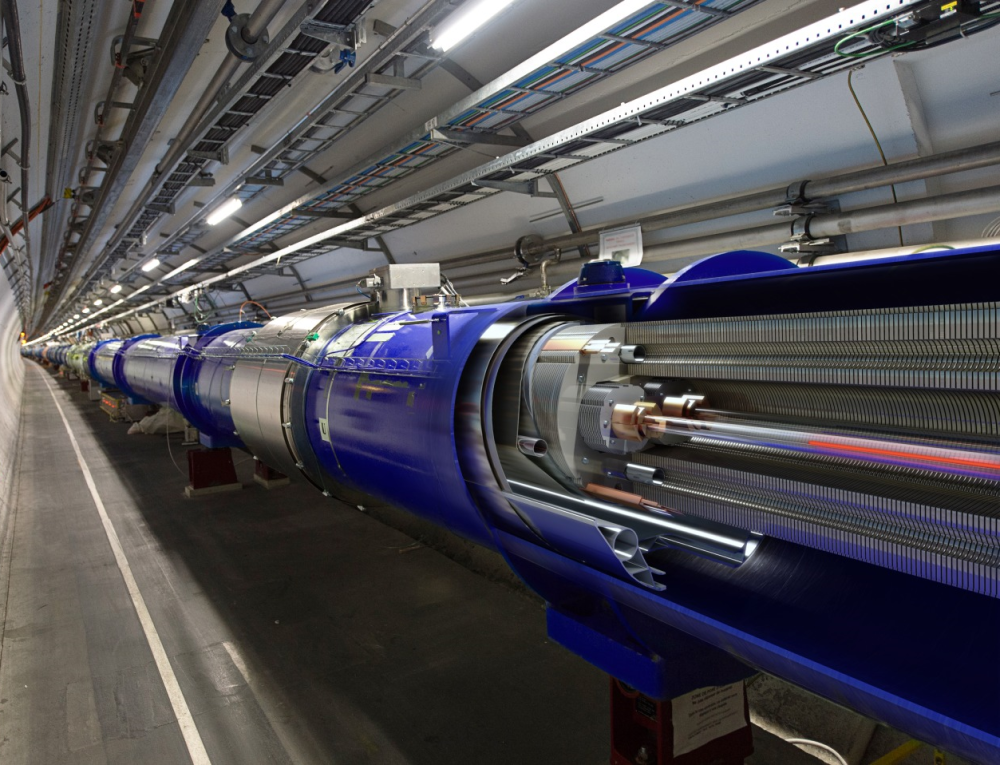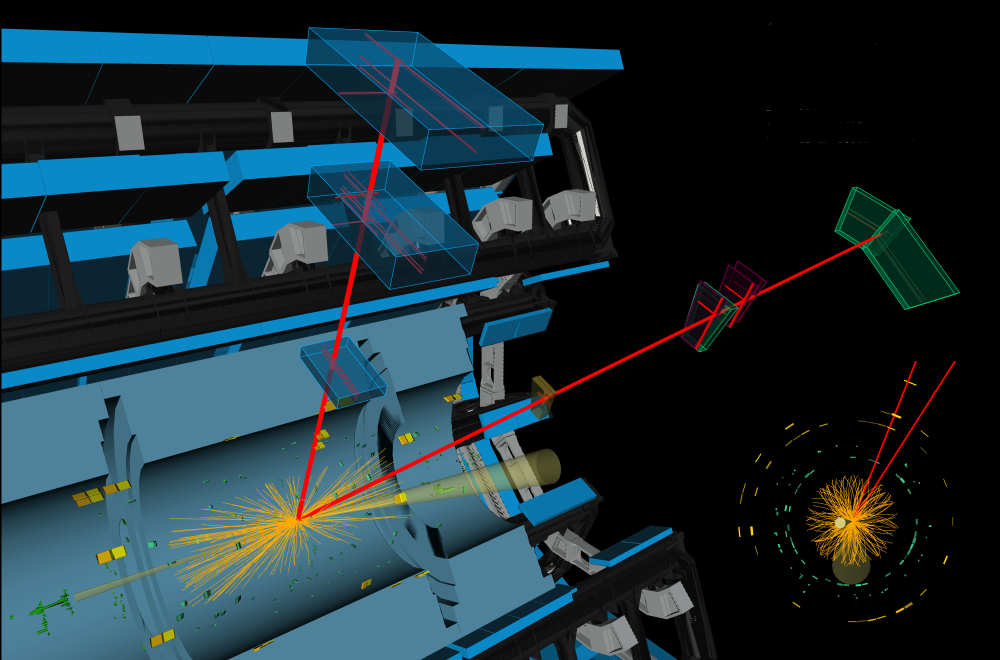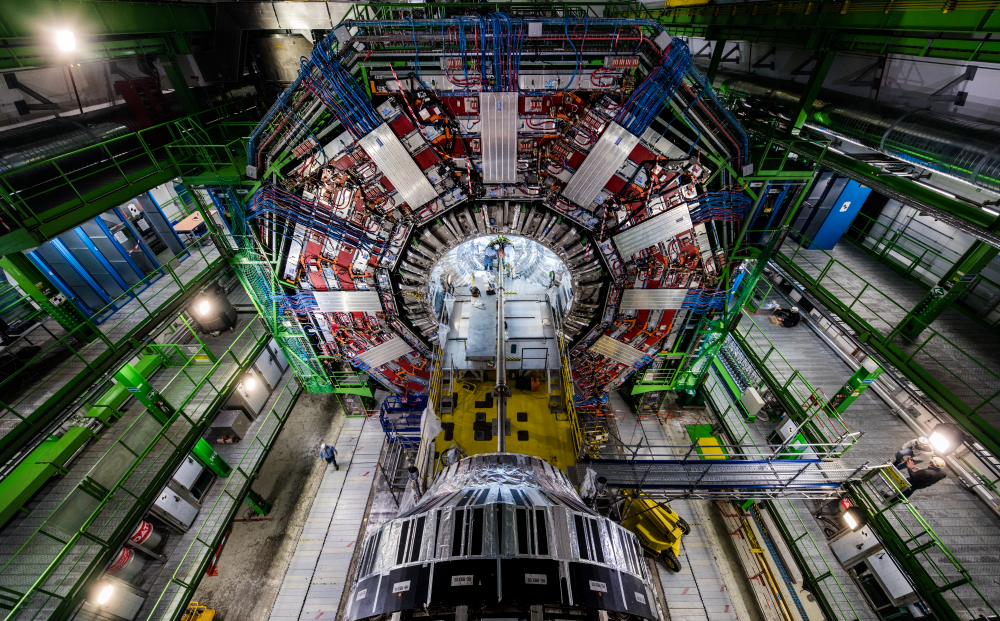The Era of Higgs Physics
This article is part of a series of pieces that Physics Magazine is publishing to celebrate the 10th anniversary of the Higgs boson discovery. See also: Poem: Higgs Boson: The Cosmic Glyph; Research News: A Particle is Born: Making the Higgs Famous; Q&A: The Higgs Boson: A Theory, An Observation, A Tool; Podcast: The Higgs, Ten Years After; and Collection: The History of Observations of the Higgs Boson.
On July 4, 2012, the discovery of a new particle was announced to a packed house at CERN in Switzerland. After presentations from the two main experimental collaborations of the Large Hadron Collider (LHC), then-CERN Director General Rolf Heuer took the stage. “As a layman, I would now say ‘I think we have it,’” he quipped. “You agree?” The audience—mostly physicists, including the particle’s namesake—cheered for the discovery of the Higgs boson.
Since then, elation has mellowed, sobered by the sense that the Higgs boson is just another confirmation of the standard model, the theory of particles of matter—fermions—and their force-carrying counterparts—bosons. Despite its success, the standard model frustratingly lacks explanations for phenomena such as dark matter, gravity, and neutrino masses. If the Higgs boson had unexpected features, it might have given researchers a hint as to how to explain these missing pieces. As is, the Higgs’s failure to deviate from existing theory has left researchers adrift, without any clear route to theories beyond the standard model.
Or so the story often goes. It is true that after ten years, nothing about the Higgs boson disagrees with the standard model predictions. But for the physicists who work on Higgs physics, this is a myopic view. Focusing on the lack of new physics ignores what has been learned about the Higgs boson over the past decade—and what more there is to learn.
“Precision Higgs physics must be the toughest to publicize to the general public because you know, they will say, ‘well, if you already measured this, why does this matter?’” says Marcela Carena, a theoretical physicist at Fermilab in Illinois. “But in reality, it matters a lot.”
For the last decade, scientists have worked to verify that the discovered Higgs is indeed the same Higgs boson that theorists predicted. Researchers at ATLAS and the Compact Muon Solenoid (CMS)—the LHC’s general-purpose experiments—continue to put the particle through increasingly rigorous tests, using novel techniques to uncover events—such as rare Higgs decays—that are hidden among similar-looking events or “backgrounds.” This ongoing effort offers a clear payoff, as it could answer outstanding questions related to how the Higgs couples to other particles and whether it is but one of many Higgs-like particles. Determining these Higgs properties, Carena points out, could also address underlying mysteries, such as the nature of dark matter or the origin of matter-antimatter asymmetry.
Far from being a theoretical dead-end, the Higgs is more important than ever. “The Higgs boson is a unique particle that raises profound questions about the fundamental laws of nature,” the authors of the 2020 European Strategy Update wrote. “It also provides a powerful experimental tool to study these questions.”
The Devil in the Details
With hindsight, the discovery of the Higgs boson can appear foreordained, as though it was only a matter of time until the correct theory was confirmed. But in the years leading up to 2012, the Higgs discovery was far from certain.
The standard model predicts that elementary particles acquire their mass through the field that is associated with the Higgs boson. But right up to the discovery, theorists were still writing papers about mass-generating mechanisms that did not involve the Higgs. These models were not as popular among theorists but still carried weight so long as the Higgs remained undiscovered.
At the same time, experimentalists were having their own doubts. In 2011, ATLAS began seeing a signal indicative of a Higgs—but only in W-boson decays, which could not provide a precise Higgs mass. “People were really so anxious about the new data,” says Marumi Kado, the ATLAS Collaboration deputy spokesperson. “There was not a feeling of inevitability.”
By early 2012, hints of a possible Higgs boson with a mass of around 125 GeV were around the three-sigma benchmark, a measure of statistical significance that is lower than the five-sigma level conventionally used to claim a discovery. “I think at that point, it was clear that we were likely going to hit a discovery with the additional data that we were going to collect,” says Nicholas Wardle, an experimentalist and coleader of Higgs physics for the CMS Collaboration.
The discovery came in July, but LHC researchers initially referred to the detected particle as a “Higgs boson candidate,” as major uncertainties remained even after the announcement. Some of the early data suggested, for example, that the new particle was decaying into two photons at double the rate predicted by the standard model. The excess fueled speculation that the detected particle might have spin 2, not the predicted spin 0. “There were a lot of bolts that needed to be tightened,” Kado says. “It was nerve-racking.”
With the full Run 1 dataset available by 2013, researchers were able to put some worries to bed. The newly discovered Higgs is indeed a spin-0 particle, and it is CP-even—meaning that it couples to particles in the same way that it couples to antiparticles with reversed parity. Additionally, measurements from ATLAS and CMS managed to pin down the Higgs mass to 125 GeV, with an error of less than 1%.
Getting to Know the Higgs
Run 2, which went from 2015 to 2018, allowed ATLAS and CMS to increase their data sixfold. “We just had so much more data,” Wardle says. “That opens up a whole new realm of possibilities.” New machine-learning approaches were able to sift through noisy backgrounds, clearly identifying particles like bottom quarks, even amid the wreckage of a messy collision.
On the theory side, researchers went to extreme lengths to reduce uncertainties, using so-called next-to-next-to-leading order calculations for processes such as top quark production. By considering additional, smaller terms in the infinite series that represents the interaction between two particles, they were able to make unprecedentedly precise predictions. Improvements to the detectors also enabled better event discrimination.
Representative of this progress are measurements of the Higgs decay to two muons. The signal for this rare event is normally lost in the noise of Z-boson decays to two muons. Despite the difficulty of the search, the ATLAS and CMS collaborations recently reported three-sigma evidence for the Higgs decaying to two muons—providing hope that researchers will soon claim discovery of this seemingly out-of-reach detection.
The decay to muons is unique in that it would be the first evidence of the Higgs interacting with a lighter fermion—previous observations of Higgs-fermion interactions have all involved the heaviest fermion generation (bottom quark, top quark, and tau lepton). Discovering that all mass-bearing particles get their heft from the Higgs would be a critical confirmation of the standard model and would help rule out competing theories with multiple Higgs particles.
Because the Higgs was expected to couple with muons, this development has been met with muted enthusiasm. In fact, many physicists are finding the Higgs to be a bit too “standard” for their tastes, with no signs of new physics that might expose cracks in the standard model. Excitement temporarily rose in 2015 when strange data appeared at energies of 750 GeV, but the anomaly was later found to be a statistical fluke.
Other results, such as the discovery of the Higgs coupling to the top quark, have met similarly subdued reactions. “We didn’t make a sufficient amount of fuss,” laments Kado. He says that people assume that a result that matches the standard model must be obvious, when in fact much about the Higgs has yet to be established by experiment.
Standard Remodeling
Standard model or not, the Higgs itself revolutionized the field. “There was a blossoming of new ideas, and the landscape of particle physics completely changed,” says Kado. Carena agrees: “After you discover the Higgs, the first question you have is, ‘Well, why not more of that kind?’” Many theorists have wondered about models with multiple Higgs particles, possibly hiding at higher energies, or even entire sectors connected to the Higgs.
Models with Higgs portals—connections to a coterie of extremely feebly interacting particles coupling only to the Higgs—have flourished because of their ability to explain dark matter and other outstanding issues with the standard model. Supersymmetric (SUSY) theories—which propose a new symmetry between bosons and fermions—still have a place in the theorist’s toolbox, but because of a lack of evidence, they are no longer predominant. Instead, theorists work more closely with experimental results. “There are a lot of inputs we have gotten from experimental data that have constrained the way we build models,” Carena says.
New ideas from theorists have also shaped the experimental program. This fruitful interplay is perhaps best encapsulated by the effective field theory (EFT) approach at the LHC. Using the EFT approach, theorists can guide experimentalists to make precision measurements sensitive to undiscovered particles. For example, the decay of a Higgs to a Z boson and a photon is mediated by contributions from all particles. If the decay rate deviates from predictions, that could be a sign of an unseen heavy particle.
Even if a Higgs decay matches standard model predictions, it can still provide valuable information. Some alternative Higgs models, Wardle points out, predict that the Higgs boson couples to leptons, such as the electron, differently than to quarks. As such, determining all the coupling strengths and other Higgs parameters isn’t stamp collecting—as some derisively call such measurements—but a vital effort to put limits on theories, he says.
Run 3 will begin in earnest on July 5, 2022, the day after the 10th anniversary of the Higgs discovery, promising particle physicists a new tranche of data to pore over. Wardle hopes data will allow CMS to reach five sigma and declare a discovery for the Higgs decay to two muons. LHCb (one of the more-specialized LHC experiments) could play a role as well by probing the Higgs coupling to charm quarks. The search for beyond-the-standard-model Higgs properties is “now one of the main pillars of the CMS search program,” says Jan Steggemann, a coleader of Higgs physics for the CMS Collaboration. Carena is particularly interested in the Higgs’ self-coupling, which the High Luminosity LHC—an upgrade planned for 2029—will be able to measure via two-Higgs production.
Accelerating Improvements
In 1975, the first paper on Higgs boson “phenomenology”—data-driven predictions—concluded with regrets from the authors: “We apologize to experimentalists for having no idea what is the mass of the Higgs boson.” They were also sorry for being unsure about its couplings to other particles. “For these reasons, we do not want to encourage big experimental searches for the Higgs boson.” Four decades later, physicists have not only found the Higgs, but they have assembled a collection of millions of detections of these elusive particles using the LHC as the world’s first “Higgs factory” (see Opinion: Exploring Futures for Particle Physics).
What was once too inaccessible to dream of has become standard, in part because physicists have surpassed their own projections. “There were people who claimed that the LHC was too ‘dirty’ a machine,” Steggemann says, referring to large backgrounds that can obscure small signals. But he says that physicists have developed techniques, such as machine learning, that can filter through the dirt. And those efforts are paying off, as once-thought-impossible measurements, like the Higgs decay to two muons, are now eminently possible.
Ten years after its discovery, the Higgs may have disappointed some with its adherence to the standard model. But its apparent conformity has proven useful, and its remaining secrets continue to inspire particle physicists. “I don’t think particle physics is in a crisis—we have so many things to explain,” Carena says. “I would call it an opportunity.”
Correction (6 July 2022): This story has been updated with the correct dates of LHC’s Run 2 and a clarification of the role played by the Higgs field in generating mass.
–Dan Garisto
Dan Garisto is a science journalist based in New York City.







